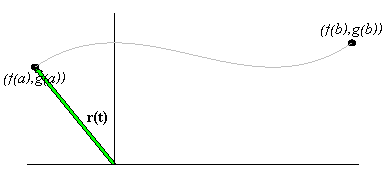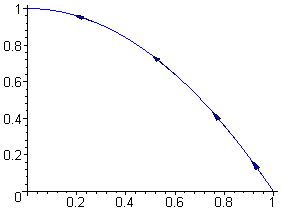Part 1: Vector-Valued Functions
Now that we have introduced and developed the concept of a vector, we are
ready to use vectors to define functions. To begin with, a vector-valued function is a function whose inputs are a parameter t and whose outputs are vectors r( t) .
In 2 dimensions, a vector-valued function is of the form
If f and g are continuous functions over [a,b], then the set of position vectors of the form r( t) =
á f( t) ,g( t)
ñ for t in [ a,b] forms a curve whose orientation is in the
direction in which the parameter is increasing. The point
r(a) = (f(a),g(a)) is called the initial point of the curve, and the
point
r(b) = (f(b),g(b)) is the curve's terminal point.
 |
|
click image to toggle animation |
|
The function r( t) =
á f(t) ,g( t)
ñ , t in [ a,b] , is
called a parametrization of the curve. To sketch the
curve, we often let
|
x = f( t) , y = g( t) , t in [ a,b] |
|
and then eliminate the parameter t in hopes of obtaining a familiar
equation in x and y.
EXAMPLE 1 Sketch the curve parametrized by r(t) =
á 1-t2,2t2-t4
ñ for t in [ 0,1] .
Solution: To begin with, x = 1-t2, which means that t2 = 1-x.
Since y = 2t2-t4, that means that
which simplifies to y = 1-x2. Moreover, the initial and terminal points
are
That is, the graph of r( t) =
á1-t2,2t2-t4
ñ for t in [ 0,1] is the
section of the graph of y = 1-x2 between the initial point (1,0) and the terminal point ( 0,1) .

If r( t) =
á f(t) ,g( t)
ñ , t in [ a,b] , parameterizes an oriented
curve C and if r(a)
= r(b) , then C is a closed curve.
EXAMPLE 2 Sketch the curve
parameterized by u(q) =
á cos(q), sin(q)
ñ for q in [ 0,2p] .
Solution: Since x = cos(q) and y = sin(q), we begin with
Thus, the identity implies that
which is the unit circle. Moreover, the initial and terminal points are
Since the initial and terminal points are both (1,0), we can determine the
orientation of the circle by examining if an angle close to 0 produces a point
above or below the unit circle. For example, u(p/4)
is in the first quadrant, thus showing that the orientation of the curve is
counterclockwise:

|
|
click to toggle animation |
|
Example 2 is a revisitation of a fundamental idea in trigonometry, which is
that the standard parameterization of the unit circle is given by
|
u(q) =
á cos(q), sin(q)
ñ |
| |
where θ is in radians. The use of the letter "u" is because
u(q)is a unit vector for each value of the angle q.
Check your Reading: How would we simplify (1) to y = 1-x2?


